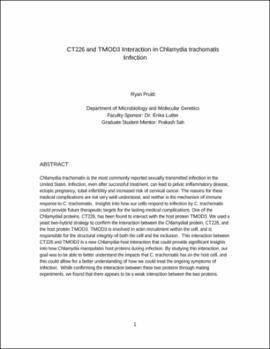| dc.description.abstract | Chlamydia trachomatis is the most commonly reported sexually transmitted infection in the United States. Infection, even after successful treatment, can lead to pelvic inflammatory disease, ectopic pregnancy, tubal infertility and increased risk of cervical cancer. The reasons for these medical complications are not very well understood, and neither is the mechanism of immune response to C. trachomatis. Insights into how our cells respond to infection by C. trachomatis could provide future therapeutic targets for the lasting medical complications. One of the Chlamydial proteins, CT226, has been found to interact with the host protein TMOD3. We used a yeast two-hybrid strategy to confirm the interaction between the Chlamydial protein, CT226, and the host protein TMOD3. TMOD3 is involved in actin recruitment within the cell, and is responsible for the structural integrity of both the cell and the inclusion. This interaction between CT226 and TMOD3 is a new Chlamydia-host interaction that could provide significant insights into how Chlamydia manipulates host proteins during infection. By studying this interaction, our goal was to be able to better understand the impacts that C. trachomatis has on the host cell, and this could allow for a better understanding of how we could treat the ongoing symptoms of infection. While confirming the interaction between these two proteins through mating experiments, we found that there appears to be a weak interaction between the two proteins. | |
